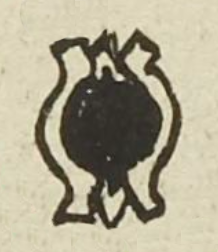Olli (MH591r)
This black-line drawing of the compound glyph for the personal name Olli (“Rubber" or "Rubber Ball,” attested here as a man’s name) shows a black ball (olli) wrapped with the quincunx shape associated with the glyph for movement (olin).
Stephanie Wood
The glyphs for the names Olli and Olin in the Matrícula de Huexotzinco can be nearly identical, and it can be a challenge to know which part is the logogram and which part is the phonetic support. The glosses are only somewhat helpful, given that "n" gets inadvertently added or dropped away with regularity in alphabetic Nahuatl. Here, the sign for movement (olin) seems to play a smaller role, and if so, it is a phonetic complement to olli.
Furthermore, rubber and movement have things in common. Rubber jiggles, and rubber balls bounce and move through the ball courts in a way that was perceived to be like the sun moving through the day. All that said, native speakers at IDIEZ do distinguish between the nouns olli (rubber) and olin (movement).
Stephanie Wood
juan olli
Juan Olli
Stephanie Wood
1560
Jeff Haskett-Wood
rubber, hule, movement, movimiento, ball, pelota

ol(li), rubber, https://nahuatl.wired-humanities.org/content/olli
ol(in), movement, https://nahuatl.wired-humanities.org/content/olin
El Hule (or El Movimiento)
Stephanie Wood
Matrícula de Huexotzinco, folio 591r, https://www.loc.gov/resource/gdcwdl.wdl_15282/?sp=261
This manuscript is hosted by the Library of Congress and the World Digital Library; used here with the Creative Commons, “Attribution-NonCommercial-ShareAlike 3.0 License” (CC-BY-NC-SAq 3.0).






